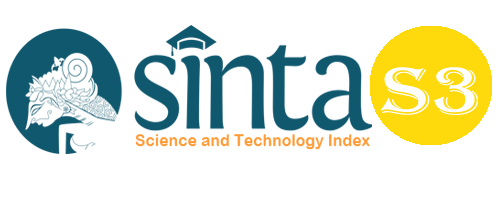Improving the Quality of the Mobile Tax Service Apps in Indonesia: A Delphi Study
Abstract
This research aims providing recommendations to improve the service quality of M-Pajak, a mobile-based application developed by the Directorate General of Tax (DGT). M-Pajak was officially launched in June 2021 to simplify and modernize the pre-existing traditional tax services. Eight selected experts participated as persons in this research and exchanged their ideas through a three-round Delphi study carried out from November 2021 to January 2022. The initial release of the application only provides a minimal number of services. Due to limited human resources, the DGT needs a selective development improvement plan for public service apps. This research found that data and information security should be prioritized for future M-Pajak updates.
Keywords
Full Text:
PDFReferences
Al-Nidawi, W. J. A., Al-Wassiti, S. K. J., Maan, M. A., & Othman, M. (2018). A review in E-government service quality measurement. Indonesian Journal of Electrical Engineering and Computer Science, 10(3), 1257-1265. https://doi.org/10.11591/ijeecs.v10.i3.pp1257-1265
Badan Pusat Statistik. (2021). Indeks Pembangunan Teknologi Informasi dan Komunikasi 2020.
Baskerville, R., Rowe, F., & Wolff, F.-C. (2018). Integration of Information Systems and Cybersecurity Countermeasures: An Exposure to Risk Perspective. SIGMIS Database, 49(1), 33–52. https://doi.org/10.1145/3184444.3184448
Boiko, A., & Shendryk, V. (2017). System Integration and Security of Information Systems. Procedia Computer Science, 104, 35-42. https://doi.org/10.1016/j.procs.2017.01.053
Chan, F. K. Y., Thong, J. Y. L., Brown, S. A., & Venkatesh, V. (2021). Service Design and Citizen Satisfaction with E-Government Services: A Multidimensional Perspective. Public Administration Review, 81(5), 874-894. https://doi.org/10.1111/puar.13308
Chen, J. V., Jubilado, R. J. M., Capistrano, E. P. S., & Yen, D. C. (2015). Factors affecting online tax filing - An application of the IS Success Model and trust theory. Computers in Human Behavior, 43, 251-262. https://doi.org/10.1016/j.chb.2014.11.017
Connolly, R., Bannister, F., & Keaney, A. (2010). Government website service quality: A study of the Irish revenue online service. European Journal of Information Systems, 19. https://doi.org/10.1057/ejis.2010.45
Crawford, M., & Wright, G. (2016). Delphi Method. Wiley StatsRef: Statistics Reference Online, 1-6. https://doi.org/10.1002/9781118445112.stat07879
Dinoroy Marganda, A. (2017). The Impact of E-Government System on Public Service Quality in Indonesia. European Scientific Journal, ESJ, 13(35). https://doi.org/10.19044/esj.2017.v13n35p99
Fu, B., Lin, J., Li, L., Faloutsos, C., Hong, J., & Sadeh, N. (2013). Why people hate your app: making sense of user feedback in a mobile app store Proceedings of the 19th ACM SIGKDD international conference on Knowledge discovery and data mining, Chicago, Illinois, USA. https://doi.org/10.1145/2487575.2488202
Hendayana, Y. et.al. (2021). How Perception use of e-Filling Technology Enhance Knowledge of Indonesian Disability Taxpayers and Impact Tax Compliance. Budapest International Research and Critics Institute-Journal (BIRCI-Journal) Vol 4 (2): 1687-1696.
Huang, E. Y., Lin, S.-W., & Fan, Y.-C. (2015). M-S-QUAL: Mobile service quality measurement. Electronic Commerce Research and Applications, 14(2), 126-142. https://doi.org/10.1016/j.elerap.2015.01.003
Jang, J., & Lee, K. (2019). Transforming a Specialized Q&A System to a Chatbot System: A Case of a Simplified Taxation in Korea. In C. Stephanidis & M. Antona (Eds.), 21st International Conference on Human Computer Interaction, HCII 2019 (Vol. 1088, pp. 296-308): Springer Science and Business Media Deutschland GmbH.
Joni, & Handryno. (2021). The Effect of Tax Service Quality on Taxpayer Compliance in Paying Land and Building Tax. The Effect of Tax Service Quality on Taxpayer Compliance in Paying Land and Building Tax, 11(7), 637-642. https://doi.org/10.29322/IJSRP.11.07.2021.p11583
Kapetanopoulou, P., & Kouroutzi, A. (2021). An Empirical Study of Drivers, Barriers, and Cost Efficiency of Information Systems in Greek Industry. Applied Sciences, 11(8), 3475. https://www.mdpi.com/2076-3417/11/8/3475
Lu, Y. (2017). Industry 4.0: A survey on technologies, applications and open research issues. Journal of Industrial Information Integration, 6, 1-10. https://doi.org/10.1016/j.jii.2017.04.005
Maganya, M. H. (2020). Tax revenue and economic growth in developing country: an autoregressive distribution lags approach. Central European Economic Journal, 7(54), 205-217. https://doi.org/10.2478/ceej-2020-0018
Manoharan, A. (2014). E-Government and Websites: A Public Solutions Handbook. Routledge.
Marpaung, A. (2020). Zakat Regulation as a Reduction of Income Tax in Indonesia. Budapest International Research and Critics Institute-Journal (BIRCI-Journal) Vol 3 (3): 2109-2116.
Nath, A., & Mondal, T. (2016). Issues and Challenges in Two Factor Authentication Algorithms. International Journal of Latest Trends in Engineering and Technology (IJLTET), 6, 318-327.
Ntaliani, M., & Costopoulou, C. (2018). E-Government for Lowering Administrative Burden: An Empirical Research on European Rural Businesses. International Journal of Public Administration, 41(9), 700-711. https://doi.org/10.1080/01900692.2017.1296865
Oktaviani, A. A., Juang, F. T., & Kusumaningtyas, D. A. (2019). The Effect of Knowledge and Understanding Taxation, Quality of Tax Services, and Tax Awareness on Personal Tax Compliance. Indonesian Management and Accounting Research, 16(2), 13. https://doi.org/10.25105/imar.v16i2.4678
Özer, A., Tokay Argan, M., & Argan, M. (2013). The Effect of Mobile Service Quality Dimensions on Customer Satisfaction. Procedia - Social and Behavioral Sciences, 99, 428-438. https://doi.org/10.1016/j.sbspro.2013.10.511
Parasuraman, A., Zeithaml, V. A., & Malhotra, A. (2005). E-S-QUAL: A Multiple-Item Scale for Assessing Electronic Service Quality. Journal of Service Research, 7(3), 213-233. https://doi.org/10.1177/1094670504271156
Sadress, N., & Juma, B. (2019). The mediating role of adoption of an electronic tax system in the relationship between attitude towards electronic tax system and tax compliance. Journal of Economics, Finance and Administrative Science, 25. https://doi.org/10.1108/JEFAS-07-2018-0066
Sania, A. F., & Yudianto, I. (2018). Analysis of Factors that Influence Taxpayers Compliance in Fulfilling Taxation Obligations. Journal of Accounting Auditing and Business, 2(1), 17-27. https://doi.org/10.24198/jaab.vli2.18270
Siregar, R., Nasution, I.R., and Arifin, M.A. (2019). The Effect of Corporate Taxpayer Compliance, the Increase of Corporate Taxpayers' Number and Tax Audits on Income Tax Receipts of Article 25 with Taxation Sanctions as a Moderating Variable in KPP Pratama Medan Petisah. Budapest International Research and Critics Institute-Journal (BIRCI-Journal) Vol 2 (4): 385-400.
Stiakakis, E., & Georgiadis, C. (2014). Building a Measurement Framework for m-Government Services. International Journal of Information Systems and Social Change, 3, 18-37. https://doi.org/10.4018/jissc.2012100102
Sukesi, S., & Yunaidah, I. (2020). The Effect of Tax Socialization, Superior Service, and Service Quality on Taxpayers’ Satisfaction and Compliance. Journal of Economics, Business, & Accountancy Ventura; Vol 22, No 3 (2019): December 2019 - March 2020. https://doi.org/10.14414/jebav.v22i3.1698
Susuawu, D., Kenneth, O.-B., & Amoh, J. (2020). Does Service Quality Influence Tax Compliance Behaviour of SMEs? A New Perspective from Ghana. International Journal of Economics and Financial Issues, 10, 50-56. https://doi.org/10.32479/ijefi.10554
Thai, H. D., & Huh, J. H. (2021). Building an operational solution assistant system for foreign SMEs in ROK [Article]. Applied Sciences (Switzerland), 11(10), Article 4510. https://doi.org/10.3390/app11104510
Thangaratinam, S., & Redman, C. W. (2005). The Delphi technique. The Obstetrician & Gynaecologist, 7(2), 120-125. https://doi.org/10.1576/toag.7.2.120.27071
Venkatesh, V., Thong, J., Chan, F., & Hu, P. (2016). Managing Citizens’ Uncertainty in E-Government Services: The Mediating and Moderating Roles of Transparency and Trust. Information Systems Research, 27, 87-111. https://doi.org/10.1287/isre.2015.0612
Verkijika, S. (2020). Assessing the Role of Simplicity in the Continuous Use of Mobile Apps. Journal of Organizational and End User Computing, 32, 26-42. https://doi.org/10.4018/JOEUC.2020100102
Waheduzzaman, W., & Miah, S. J. (2015). Readiness assessment of e-government: a developing country perspective [Article]. Transforming Government: People, Process and Policy, 9(4), 498-516. https://doi.org/10.1108/TG-05-2014-0018
Wang, Y., Huang, Y., Li, J., & Zhang, J. (2021). The effect of mobile applications’ initial loading pages on users’ mental state and behavior. Displays, 68, 102007. https://doi.org/10.1016/j.displa.2021.102007
Wicaksono, P. T., Tjen, C., & Indriani, V. (2021). Improving the tax e-filing system in Indonesia: An exploration of individual taxpayers’ opinions. Jurnal Akuntansi dan Auditing Indonesia, 25(2), 136-151. https://journal.uii.ac.id/JAAI/article/view/18810
Yin, X., He, J., Guo, Y., Han, D., Li, K.-C., & Castiglione, A. (2020). An Efficient Two-Factor Authentication Scheme Based on the Merkle Tree. Sensors, 20(20), 5735. https://www.mdpi.com/1424-8220/20/20/5735
Zhao, W., Ge, Y., Qu, W., Zhang, K., & Sun, X. (2017). The duration perception of loading applications in smartphone: Effects of different loading types. Applied Ergonomics, 65, 223-232. https://doi.org/10.1016/j.apergo.2017.06.015
DOI: https://doi.org/10.33258/birci.v5i2.4614
Article Metrics
Abstract view : 112 timesPDF - 66 times
Refbacks
- There are currently no refbacks.

This work is licensed under a Creative Commons Attribution-ShareAlike 4.0 International License.

This work is licensed under a Creative Commons Attribution-ShareAlike 4.0 International License.

_.gif)

















_.gif)



